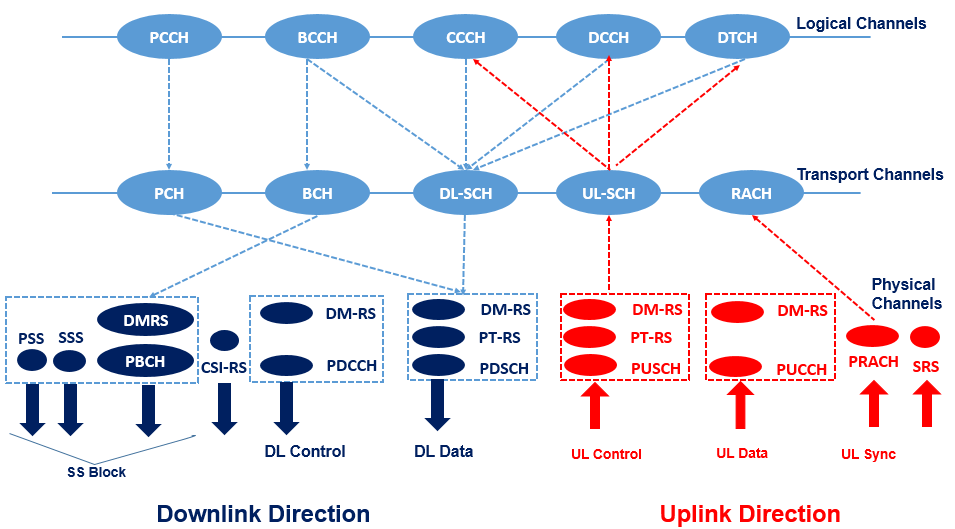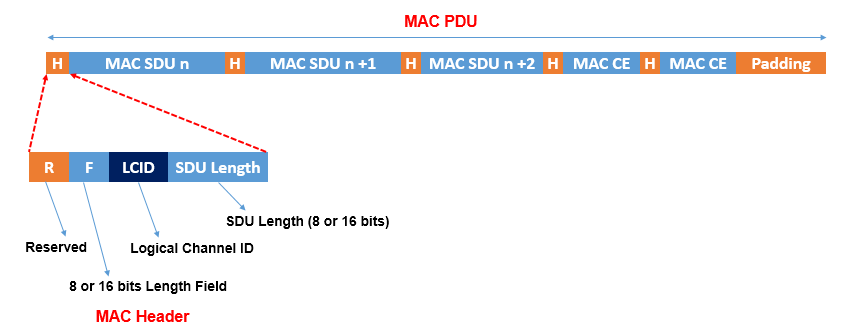5G NR Logical ,Transport and Physical Channels Mapping
Logical Channel Definition : Medium Access Control (MAC) Layer of NR provides services to the Radio Link Control (RLC) Layer in the form of logical channels. A logical channel is defined by the type of information it carry and is generally differentiated as a control channel, used for transmission of control and configuration information or as a traffic channel used for the user data.
List of Logical Channels for NR:
- Broadcast Control Channel (BCCH): It is used for transmitting system information from the network to UEs in a cell coverage. Prior to accessing the system, a UE needs to acquire the system information to find out the system configuration. BCCH channel is used in Standalone (SA) operation of NR, in the case of non-standalone operation (NSA), system information is provided by the LTE cell and there is no BCCH.
- Paging Control Channel (PCCH): This is used to page the UEs whose location at cell level is not known to the network. The paging message therefore needs to be transmitted in multiple cells. Similar to BCCH PCCH is also used in SA operation, in the case of NSA operation, paging is provided by the LTE cell and there is no PCCH.
- Common Control Channel (CCCH): It is used for transmission of control information to UEs with respect to Random Access
- Dedicated Control Channel (DCCH): It is used for transmission of control information to/from a UE. This channel is used for individual configuration of UEs such as setting different parameters for different layers.
- Dedicated Traffic Channel (DTCH): It is used for transmission of user data to/from a UE. This is the logical channel type used for transmission of all unicast uplink and downlink user data.
Transport Channel Definition: A transport channel is defined by how and with what characteristics the information is transmitted over the radio interface. From the physical layer, the MAC layer uses services in the form of transport channels. . Data on a transport channel are organized into transport blocks.
List of Transport Channels for NR:
- Broadcast Channel (BCH) : It is used for transmitting the BCCH system information, more specifically Master Information Block (MIB). It has a fixed transport format, provided by the specifications.
- Paging Channel (PCH): This channel is used for transmission of paging information from the PCCH logical channel. The PCH supports discontinuous reception (DRX) to allow the device to save battery power by waking up to receive the PCH only at predefined time instants.
- Downlink Shared Channel (DL-SCH) : This is the main transport channel used for transmitting downlink data in NR. It supports key all NR features such as dynamic rate adaptation and channel aware scheduling, HARQ and spatial multiplexing. DL-SCH is also used for transmitting some parts of the BCCH system info which is not mapped to the BCH. Each device has a DL-SCH per cell it is connected to. In slots where system information is received there is one additional DL-SCH from the device perspective.
- Uplink Shared Channel (UL-SCH): This is the uplink counterpart to the DLSCH that is, the uplink transport channel used for transmission of uplink data.
- Random-Access Channel (RACH): RACH is also a transport channel, although it does not carry transport blocks.
Logical, Transport and Physical Channel Mapping:
As a part of MAC layer’s multiplexing/de-multiplexing function mapping of the logical channels to the appropriate transport channels is done. The mapping between logical channel and transport channel is shown in Figure below. This figure clearly indicates how DL-SCH and UL-SCH are the main downlink and uplink transport channels, respectively.
In the figures, the mapping between logical, transport channels and physical channels is illustrated.

To support priority handling, multiple logical channels at MAC layer, each logical channel given its own RLC entity, which can be multiplexed into one transport channel by the MAC layer. At the receiver, the MAC layer handles the corresponding de-multiplexing and forwards the RLC PDUs to their respective RLC entity. To support the de-multiplexing at the receiver, a MAC header is used.
The placement of the MAC headers has been improved in NR compared to LTE, considering the low latency applications in mind. Instead of placing all the MAC header information at the beginning of a MAC PDU (which implies that assembly of the MAC PDU can not start until the scheduling decision is available) the sub-header corresponding to a certain MAC SDU is placed immediately before the SDU.
This helps the PDUs to be pre-processed before scheduling decision is received . If necessary, padding can be appended to align the transport block size supported in NR. The sub-header contains the identity of the logical channel (LCID) from which the RLC PDU originated and the length of the PDU in bytes. There is also a flag indicating the size of the length indicator, as well as a reserved bit for future use as shown in above figure.
In addition to multiplexing of different logical channels, the MAC layer can also insert MAC control elements into the transport blocks to be transmitted over the transport channels. A MAC control element is used for inband control signaling and identified with reserved values in the LCID field, where the LCID value indicates the type of control information.
Related Post
- 5G NR RA-RNTI Calculation
- 5G NR Msg2 Random Access Response (RAR)
- 5G NR QoS Parameters
- 5G NR QoS characteristics
